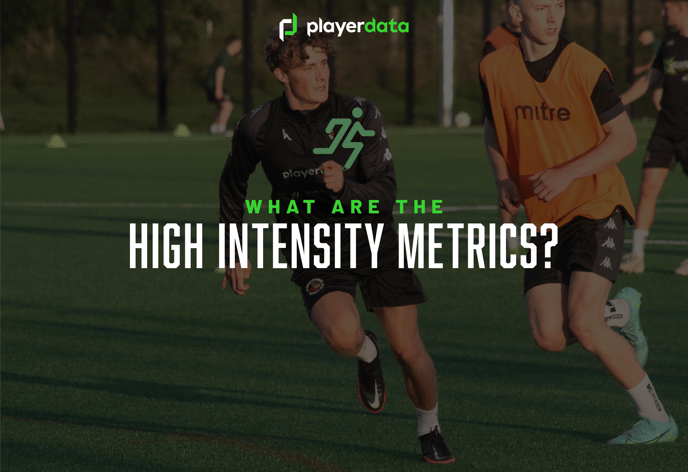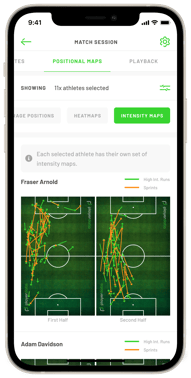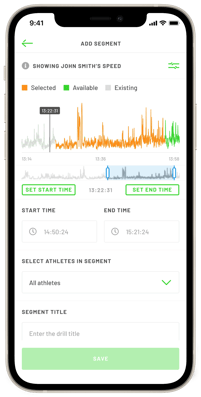What are the High Intensity Metrics?
What is high intensity running distance and number of high intensity events? How are they measured and why are they useful?

What do they measure?
High intensity running distance: is defined as the distance covered by a player in the ‘High Intensity Running’ zone.This is calculated as a cumulative distance where the player’s speed lies within the ‘High Intensity Running’ boundaries set in your club speed zones.
No. of High Intensity Events: These are ‘High Intensity Running’ efforts and are counted when a player's speed remains within the ‘High Intensity Running’ boundaries for at least 0.5 seconds.
For example an over 20s team high intensity boundaries are preset as anything between 19.8kph-25.0kph. These can be customised in the app for each team.
How to better understand the metric?
The high intensity running metric can be set at a variable value for teams based on their average max speed. We recommend setting this at 70% of your max speed. This means that the high intensity runs are unique for each team and their performance level. This also means that there is no inaccurate recording of different speed metrics. Football involves periods of intense activity followed by slower walking or jogging. Players need to quickly change their energy and speed throughout the match. It is crucial for the team to train for these rapid changes in tempo to enhance their gameplay. The high intensity metric provides coaches and players with information on when and where high intensity events occur, and whether they were utilised correctly. Having access to this data can greatly improve the quality of training sessions, allowing coaches to focus on high intensity running, which is a vital aspect of the game.
Football players typically run a distance of approximately 9 to 11 kilometres per game, depending on their positions (1). Football is characterised by intermittent bursts of high-intensity running and periods of low-intensity movements (2). Analysing the high-intensity running portion of the distance covered in a match provides valuable insights for coaches and athletes regarding their exertion levels throughout the game. However, maintaining this level of intensity for the full 90-minute match can be challenging, as high intensity distances covered tend to decrease as fatigue sets in (3). The high intensity metrics allows coaches to identify when fatigue sets in and determine the optimal moments for substitutions in order to maximise player performance and injury prevention. Our metrics provide valuable insights to ensure that players make the most out of their high-intensity running during gameplay. It is important for coaches and players to strategise before the game, this can be done by looking through the previous games in the PlayerData App which will highlight when and where a high intensity event occurred and how many metres it was performed for.
Additionally, it is important to recognise when a player is fatiguing, as decision-making abilities tend to decline during fatigue (4), which can affect passing technique and the overall direction of the match as intended by the team. As fatigue sets in, the ability to make quick and targeted decisions decline. High Intensity Running highlights the fast paced movements of the game that increase the likelihood of injury, resulting from harsh turning and abrupt braking which is taxing on the muscles and joints when they are exerting the most energy. Monitoring high intensity movements in the app allow coaches to see if an athlete is close or suffering from burnout which will put them at a higher risk of injury.
In professional female football players, the range of high-speed running can typically range between 200-900 metres, respectively. For professional male football players, the range of high-intensity running is generally between 150- 1000 metres (5). This is dependant on multiple factors such as age, position and time on the field.
Using this metric will help athletes and coaches maximise the benefits of their training sessions. Coaches can access the data to design sessions that focus on high-intensity running, which will not only reduce risk of injury but also enhance team performance.

Playerdata App Features
The PlayerData app offers several additional features that can
provide coaches and athletes with valuable insights into their high intensity data.
High Intensity Maps: This feature shows exactly where and when high intensity events took place and in what direction the athlete was moving. This is a great tool to use for discussion between team and athlete to aid in improving teamwork and tactics when in possession of the ball or when running into a more advantageous position. The app allows you to pick more than one athlete to look at, which allows a great discussion point between athletes to help become more involved in tactical game play and understand what their movements on the pitch means.

Segments: This tool is extremely helpful during training sessions as it allows the coach to specifically focus on high intensity running. The coach can create drills that target this specific aspect of the training session, such as maximal effort runs from the 18 yard box to the middle of the pitch and back, pushing the players to give their maximum effort.
Having a record of previous sessions with heat maps and intensity maps is crucial for preventing overtraining. It is important to avoid scheduling a high intensity training session immediately after an intense match. By reviewing past sessions, the coach can better plan and understand the capabilities of the athletes, leading to more effective training sessions.
References
- Radzimiński, Ł., Szwarc, A., Padrón-Cabo, A. and Jastrzębski, Z., 2019. Correlations between body composition, aerobic capacity, speed and distance covered among professional soccer players during official matches. The Journal of sports medicine and physical fitness, 60(2), pp.257-262.
- Malone, S., Owen, A., Newton, M., Mendes, B., Collins, K.D. and Gabbett, T.J., 2017. The acute: chonic workload ratio in relation to injury risk in professional soccer. Journal of science and medicine in sport, 20(6), pp.561-565.
- García-Luna, M.A., Cortell-Tormo, J.M., García-Jaén, M., Ortega-Navarro, M. and Tortosa-Martínez, J., 2020. Acute effects of ACL injury-prevention warm-up and soccer-specific fatigue protocol on dynamic knee valgus in youth male soccer players. International Journal of Environmental Research and Public Health, 17(15), p.5608.
- Gantois, P., Caputo Ferreira, M.E., Lima-Junior, D.D., Nakamura, F.Y., Batista, G.R., Fonseca, F.S. and Fortes, L.D.S., 2020. Effects of mental fatigue on passing decision-making performance in professional soccer athletes. European journal of sport science, 20(4), pp.534-543.
-
Gualtieri, A., Rampinini, E., Dello Iacono, A. and Beato, M., 2023. High-speed running and sprinting in professional adult soccer: current thresholds definition, match demands and training strategies. A systematic review. Frontiers in Sports and Active Living, 5, p.111629
